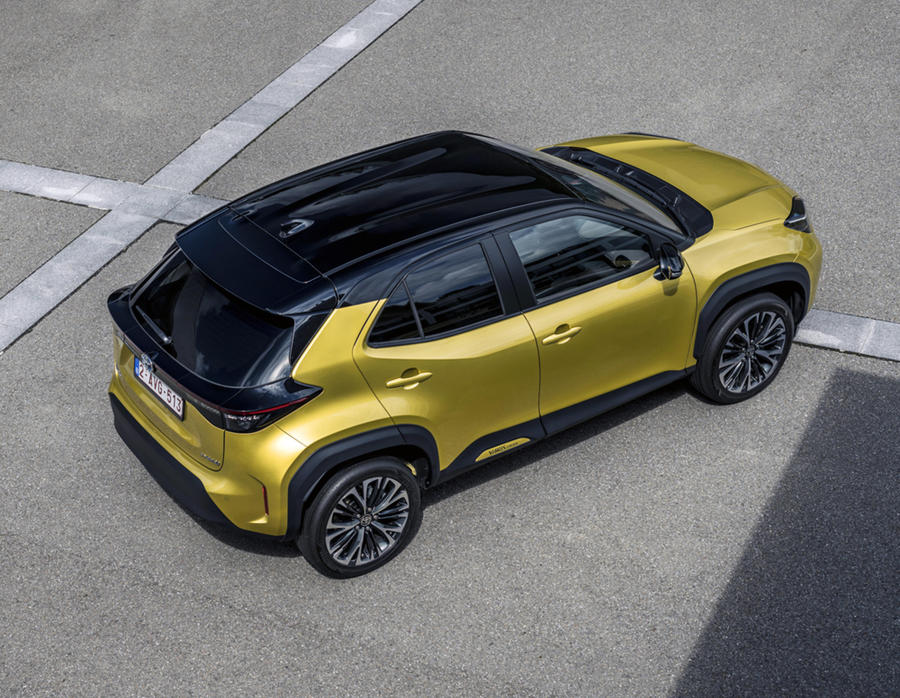Toyota Yaris Cross Hybrid, city-car doubles with the B-suv that was missing Identical platform and engine, but with integral version AWD-i Two Yaris is better than one.
Paraphrasing the famous advertising slogan of an ice cream, it is easy to explain the strategy that made Toyota decide to 'split' the Yaris family, the most successful model in Italy.
The market is asking for B-SUVs, ideal for bringing the advantages of this format (such as high driving, greater body protection and large diameter wheels) and here comes the doubling of the Yaris offer.
See photos
The B-Suv Cross retains only the platform, interior and engine of the Yaris
From next September - with a price starting from 22,650 euros in case of exchange or scrapping thanks to the WeHybrid Bonus equal to 2,750 euros - it will be possible to buy the Cross variant of the famous hybrid city-car, which should be remembered costs today (with the same promotions ) 3,700 euros less.
Yaris Cross is therefore a more accessible model, destined to broaden the audience and perfect to complete Toyota's offer in the crossover-and suv field alongside the sporty and 'streamlined' C-HR, the more traditional Rav-4 and the model top Highlander.
The launch open weekends are scheduled for 11-12 September and 18-19 September.
Designed and built in Europe to perfectly meet the needs of this market, Toyota Yaris Cross represents an important opportunity for the House of the Double Ellipse because it covers a segment that had been left to rival manufacturers and which on the Continent should represent about 30 thousand additional sales. , with the aim of undermining the normal Yaris from the top of registrations.
Naturally, the Yaris Cross is the result of Toyota's great experience in hybrid technology, but also in the design of compact cars and in the design of SUVs. It is built on the new TGA-B platform of the Japanese Group and also fully reflects the concept of 'small outside, big inside' with spacious interiors and compact external dimensions, one of the strengths of the Yaris in Italy confirmed by over a million units sold. .
4 meters long and 18 (24 cm more than the City car) and 1,595 m high (+9.5) Yaris Cross has the same wheelbase equal to 2.56 m but offering thanks to the different tires from 16 to 18 inches and modifications the suspensions have a ground clearance of 17 cm, i.e. an additional 2.5 cm. As we have been able to verify on country roads around Brussels, this different 'package' compared to the Yaris leaves handling intact but reassures when driving on uneven surfaces, especially if the version is the one equipped with four-wheel drive.
The presence - with a difference of 2,500 euros - of the AWD-i system improves stability (this version features double wishbone rear suspension) and traction in difficult conditions and on low-grip surfaces. The electric system is more compact and weighs less than mechanical AWD units, and helps the Yaris Cross Hybrid AWD-i achieve better fuel economy and CO2 emissions than comparable all-wheel drive B-SUVs.
And as is the case when driving the latest generation of the city car, the hybrid powertrain is also appreciated in the Yaris Cross, which is based on the fourth generation 116 HP 3-cylinder 1.5-liter Atkinson cycle engine. This system guarantees high efficiency with CO2 emissions starting from 100 g / km for the front-wheel drive version and from 106 g / km in the AWD-i models. Like all Toyota hybrids, the Yaris Cross also uses a particular gearbox which - in fact - is not a gearbox.
The petrol engine and the electric one are in fact connected by a planetary unit (similar to those of automatic gearboxes) which, depending on the situation and the inputs of the control unit, transmits the thrust of each of the two motors or both. Referred to as the E-CVT, it actually offers an infinite range of ratios as in classic CVT systems, which requires a little getting used to to achieve optimum performance and a smooth ride. only a speed regulation given directly by the two motors.
When the car slows down, both motors are pulled by the wheels and recharge the 0.76 kWh lithium-ion battery, very compact and housed under the sofa. By activating, even with the appropriate button, the EV mode it is possible to travel with zero emissions for a couple of km, but this can repeat itself as soon as the slowdowns have recharged the battery.
The front-wheel drive version and the AWD-i version use the same 92 Hp and 120 Nm torque engine, but differ in terms of electrical units: one integrated into the engine (80 Hp and 141 Nm) in the two-wheel drive Yaris Cross, while the AWD-i is equipped with a second induction rear engine that delivers 5.3 hp and 52 Nm of torque. The speed is identical in both cases, 170 km / h, while the 0-100 is achieved in 11.2 seconds with the front-wheel drive and 11.8 with the integral one. WLTP combined consumption is also slightly different: 4.4-5.0 liters per 100 km with the first and 4.7-5.1 with the second.

